- GreenMatch
- Blog
- Home Wind Turbines in the UK
Are Domestic Wind Turbines Worth It? Full 2025 Guide

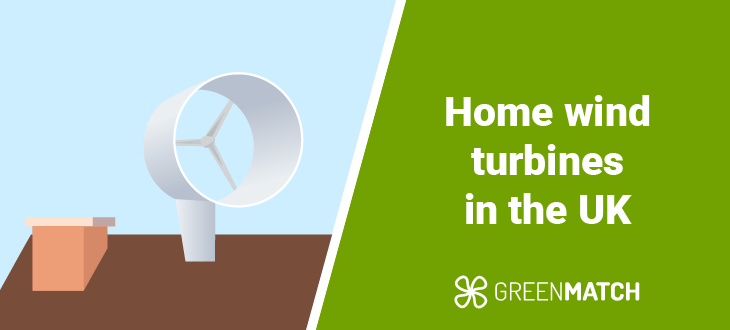
- Home wind turbines are ideal for rural and coastal areas as they have consistent wind speeds.
- The costs of home wind turbines vary from £7,000 to £70,000, with the possibility of saving £641 per year.
- Home wind turbines provide energy independence, clean power, and lower electricity bills.
Many homes are looking into renewable energy solutions as a result of the rising electricity bills and increasing desire for energy independence. Among these, home wind turbines are becoming more popular. Nevertheless, the question remains, do they make practical and economical sense for the majority of homes in the UK?
It's critical to remember that domestic wind energy is not a universally applicable option. Geographical limits, land use regulations, and the high cost of various renewable energy choices, such as solar panels, prevent many homeowners from having access to this technology.
In this piece, we’ll go in-depth about the feasibility of home wind turbines, examining their prices, benefits and disadvantages, and finding out if they’re the right choice for you. By evaluating these key points and more, we'll provide you with a detailed guide focused on home wind turbines and their prospects in the current energy landscape.
- What is a home wind turbine
- Types of home wind turbines
- Pros and cons of home wind turbines
- Wind turbines in the UK
- Costs of home wind turbines
- Installation process of home wind turbines
- Comparison of home wind turbines to other renewable energy solutions
- Is your home suitable for home wind turbines?
- Are home wind turbines worth it?
- FAQ
What is a home wind turbine?
A home wind turbine, otherwise called a residential or small wind turbine, is a device created to produce electricity for particular homes or small businesses by controlling wind energy. It’s fundamentally a small variation of the large-scale turbines you observe in wind farms, scaled down for domiciliary use. These turbines give you a way to produce your own clean energy, which will lessen their dependence on the grid and help them save costs on electricity.
Small wind turbines used for residential applications usually range in size from 400 watts to 20 kilowatts. This differs based on how much electricity you wish to generate. An average property usually utilises close to 10,649 kilowatt-hours of power per year, being that approximately 877 kilowatt-hours monthly.
How do home wind turbines work?
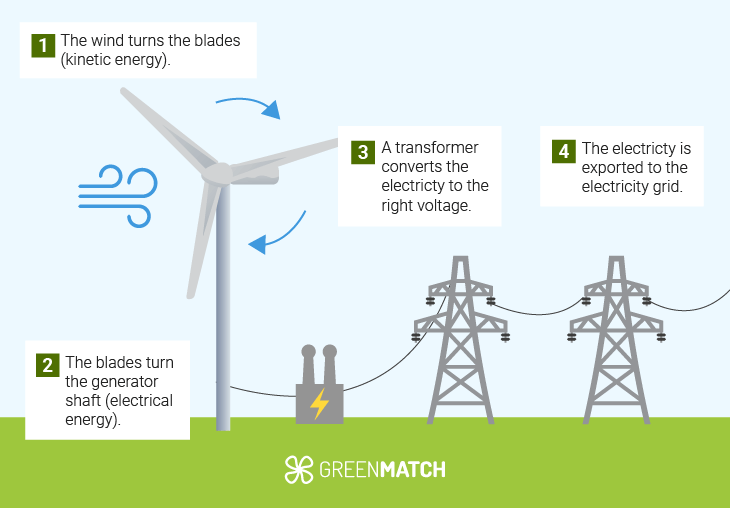
- Wind capture: The turbine’s propeller blades, attached to a central hub, catching the wind.
- Rotation: The wind's strength makes the blades rotate, turning a central ray.
- Electricity generation: This turning ray is linked to a generator placed inside the ‘nacelle’, preventing housing. This generator transforms the spinning energy into electrical energy.
- Power transformation: The produced electricity is normally converted to the right force and constant for use in your home, usually with the aid of a converter.
- Grid relatedness or facility: The created electricity can be utilized to power the property, nourish into the national grid (in the case that it’s grid-tied), or kept in batteries that are able to be used later (in off-grid systems).
Types of home wind turbines
There are two main types of wind turbines, known as horizontal axis and vertical axis. The option to choose between these types varies on elements like the available space, local wind circumstances, energy requirements, and installation demands.
The two main types of home wind turbines:
| Horizontal Axis Wind Turbines (HAWTs) | Vertical Axis Wind Turbines (VAWTs) |
|---|---|
| Most habitual type for residential private use. | Contains two subtypes: Savonius and Darrieus
|
| The blades turn around a horizontal axis. | Able to capture wind from all angles. |
| Tend to have 2 to 3 blades which are made of combined materials, such as fiberglass. | More convenient for non-rural environment domains with unstable patterns. |
| Structured to capture wind energy. | Possible to be installed near the ground. |
| Normally positioned on high towers to gain access to larger wind speeds. | Overall, it needs less maintenance. |
| For properties, the sizes vary from 400 watts to 20 kilowatts. |
Home wind turbines can come in three different sizes: small, medium, and large.
- Micro domestic turbines: Smaller models designed for domiciliary use.
- Mini wind turbines: Slightly bigger than micro domestic turbines, but still proportionately small. They are primarily used in rural or distant locations, small suburban environments or farms, and for small businesses. Homeowners should contemplate purchasing one if you own a home with strong wind surroundings, open space, and if you’re looking to reduce your dependence on the grid and reduce electric bills.
- Household-size wind turbines: Bigger systems with the ability of powering properties or small businesses.
The two installation types of home wind turbines allow them to be customized to several environments, from metropolitan rooftops to open landscapes.
- Roof-mounted turbines: More convenient to install and more affordable. However, they are usually smaller and not as powerful. With a roof-mounted turbine, you can produce around 1-2 kilowatt hours (kWh) of power. In the UK, the average roof-mounted utilises 8 kWh daily, this shows it would generate enough electricity to make sure you don’t always have to use it from the grid.
- Standalone or free-standing turbines: Successful when installed on a hill or far from obstacles. Since they’re best designed for rural homes, that makes them inadequate for urban environments. Moreover, they’re more expensive starting from £7,000 up to £70,000. Standalone wind turbines tend to produce 3-15 kWh daily, and a few of the wider designs can generate more than 25 kWh.
Pros and cons of home wind turbines
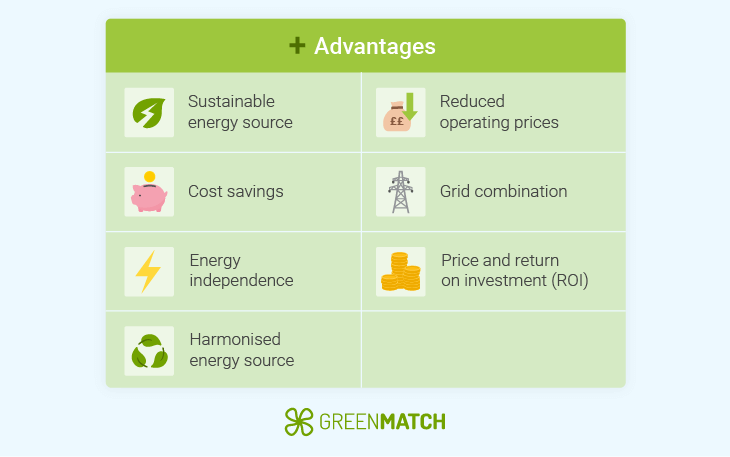
- Sustainable energy source: By generating clean energy, wind turbines lower reliance on fossil fuels and carbon footprint.
- Cost savings: By performing purchases to the grid, wind turbines can significantly reduce expenses, such as monthly electricity bills.
- Energy independence: By permitting homeowners to generate their own electricity, they contribute to power self-sufficiency.
- Harmonised energy source: Home wind turbines can boost solar power, providing a more suitable energy source throughout the whole year.
- Reduced operating prices: Once installed, wind turbines offer lower operating costs than conventional energy sources.
- Grid combination: The capacity to link with the national grid and promote excess electric power can make home wind turbines a more affordable option. Additionally, by producing revenue through active energy sales you can lower costs.
- Price and Return on Investment (ROI): The earliest bills of a wind turbine home, as well as the purchase, installation process, and maintenance, are very outstanding. The return on investment (ROI) changes based on characteristics such as wind pace, energy consumption, and available inducements. For a classic residential wind turbine system priced around £30,000, you can break even in about 7 to 10 years and enjoy up to 10 years of free renewable power. The factual payback period will differ based on your individual location, energy waste, and any accessible government inducements.
Even though the upfront expenses are high, long-term savings on power costs and the possibility of income from feed-in tariffs can transform wind turbines into a worthy investment for homeowners.
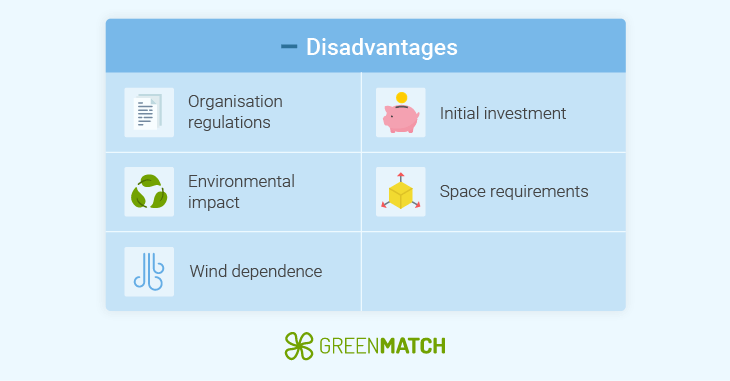
- Organisation regulations: Precise organisation adjustments and possible disapproval from neighbours makes it harder to receive the permission in certain areas for turbine installations.
- Environmental impact: While usually contemplated as a clean energy source, it’s capable of creating noise pollution and visual effects that can become an issue.
- Wind dependence: Wind accessibility, which relies on your location and the time of the year, is crucial to the production of electricity.
- Initial investment: There are notable up-front expenses associated with the purchase and installation of a home wind turbine. For instance, the price of a 1.5 kW standalone wind turbine in the UK can range from £7,000- £10,000.
- Space requirements: Home wind turbines demand sufficient space and might require authorisation for installation, which can be an obstacle in urban environments.
Points to consider when looking to install home wind turbines
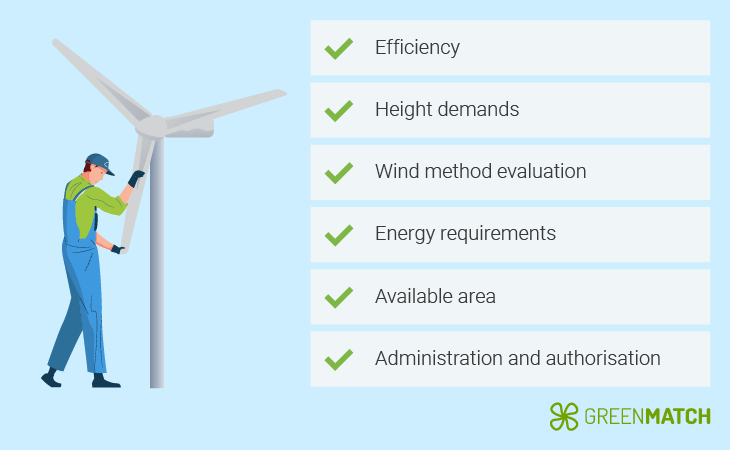
- Efficiency: Horizontal axis turbines have a 40% to 50% efficiency. On the other hand, vertical-axis turbines are less efficient. A Savonius vertical axis turbine has a usual effectiveness of 10% to 17%, and the Darrieus vertical axis turbine has 30% to 40% efficiency.
- Height demands: For ideal performance, a home wind turbine should be installed as high as possible, up to a height of 65 feet.
- Wind method evaluation: On average residential home wind turbines demand wind speeds of around 4 m/s in order to function effectively. To enhance their performance, it’s essential to learn about the different types, the average wind speeds, dominant wind directions, potential blockage and occasional patterns found in your location.
- Energy requirements: Determine your home’s usual energy spending to decide on a relevant turbine capacity.
- Available area: Make sure that your home has enough open space for installation, free from obstacles that might block wind or create issues, such as turbulence.
- Administration and authorisation: Make sure there are no restrictions in your area. Check on the turbine height, sound levels, or even occasions in which it may not be permitted to install wind turbines.
Overall, when considering the installation of wind turbines, it’s beneficial to examine your property’s location, wind resources, and municipal regulations in order to determine if it’s a rewarding option for your energy needs.
Wind turbines in the UK
Wind resources
Particularly in the UK’s coastal and mountain regions, we can find some of the most efficient wind resources in Europe. Due to this, specific areas are more appropriate for the installation of wind turbines than other areas.
Planning and regulations
The installation of a home wind turbine demands cautious consideration of local organisation instructions and rules. The process can be complex, involving planning permission, unless the turbine meets the specific ‘permitted development’ evaluation. Such as being the single turbine in the location, not being positioned in conservation areas, and following the height and boundary limitations.
Even though wind turbines in the UK have a promising future in several environments, it’s essential to carefully assess site suitability and direct planning methods before attempting
an urban wind turbine installation. Such as assessing the average wind speeds, standard wind directions, and possible impediments.
Furthermore, turbines must meet the required standards of the microgeneration certification scheme (MCS) and suburban building supervisions to secure constructional integrity and protection. Before installation, it’s recommended to discuss with your neighbors and local dominion, and to notify insurance and mortgage suppliers.
Site suitability
For a site to be appropriate for a property, it should cover the following characteristics:
- Average wind speed for no less than 5 m/s.
- The slightest irregular atmospheric motion from nearby challenges buildings, hills, trees, and so on.
- Adequate land for pole-mounted turbines.
- Not be positioned in or near a construction area or on the grounds of an older building.
Potential energy generation
Since large-scale wind farms play a remarkable part in the UK's power combinations, the capability for home wind turbines is more restricted. Nonetheless, for suitable areas, the energy generation can be considerable.
- A 1 kW turbine can generate about 800 kWh annually, covering about 28% of an average UK household’s electricity consumption.
- A 2.5 kW turbine can produce up to 3,500 kWh per year, covering about 121% of an average UK household’s electricity consumption.
- A 6 kW turbine can generate roughly 9,000 kWh yearly, covering about 310% of an average UK household’s electricity consumption.
Geographical contemplations
Urban and suburban areas in the UK are mainly not acceptable due to reduced wind speeds and more complications. Rural and coastal locations, such as Scotland, Ireland, and Cornwall, are more probable to have the appropriate conditions for home turbines.
Home wind turbine potential regions in the UK
The UK has a strong potential for home wind energy, but it’s necessary to keep in mind that not all locations work for residential wind turbines.
Here are some examples of areas with high potential for home wind turbines:
- Coastal areas of Scotland: These regions have very strong winds as they are located close to the Atlantic sea. The ongoing wind speeds and open scenery make them perfect for small-scale wind turbines.
- East Coast of England: Locations such as Suffolk and Norfolk take advantage of strong winds that come from the North Sea. The flat land and closeness to offshore wind farms designate superior wind potential for residential use.
- Welsh uplands: Areas like Brecon Beacons and Snowdonia are exposed to high wind speeds because of their elevated positions. The immense territory can form wind tunnels, increasing the capability for home wind energy.
- Northern Ireland coastline: The displayed coastal areas of Northern Ireland, especially along the north coast experience strong winds from the Atlantic, making them appropriate for small wind turbines.
- Yorkshire and Lincolnshire: These areas have a consolidation of coastal exposure and proportional flat internal regions, which can supply concordant wind speeds for home wind turbines.
These areas are distinctively suitable due to their environmental attributes that foster strong and harmonious wind patterns, which are necessary for wind energy generation at a domestic level. Moreover, based on research, the following UK regions have the highest wind potential in 2024.
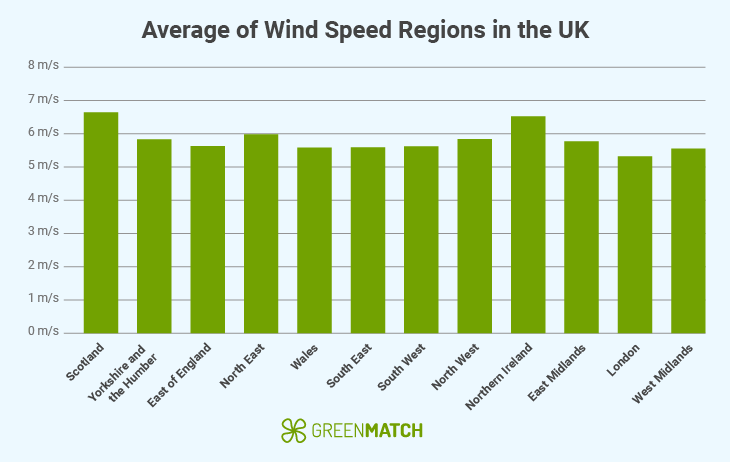
Here is an in-depth overview of the turbine potential of the UK regions:
Final sustainable potential score: 7.60/10
Average monthly wind speed at 100 meters: 6.64 m/s
Average position wind capacity factor: 37.3%
Final sustainable potential score: 7.58/10
Average monthly wind speed at 100 meters: 5.83 m/s
Average position wind capacity factor: 32.3%.
Final sustainable potential score: 7.32/10
Average monthly wind speed at 100 meters: 5.63 m/s
Average position wind capacity factor: 29.7%
Final sustainable potential score: 7.18/10
Average monthly wind speed at 100 meters: 5.98 m/s
Average position wind capacity factor: 34.6%
Final sustainable potential score: 7.15/10
Average monthly wind speed at 100 meters: 5.58 m/s
Average position wind capacity factor: 27.6%
Final sustainable potential score: 7.11/10
Average monthly wind speed at 100 meters: 5.59 m/s
Average position wind capacity factor: 28.1%
Final sustainable potential score: 7.00/10
Average monthly wind speed at 100 meters: 5.62 m/s
Average position wind capacity factor: 27.5%
Final sustainable potential score: 6.93/10
Average monthly wind speed at 100 meters: 5.84 m/s
Average position wind capacity factor: 31.1%
Final sustainable potential score: 6.90/10
Average monthly wind speed at 100 meters: 6.52 m/s
Average position wind capacity factor: 38.0%
Final sustainable potential score: 6.88/10
Average monthly wind speed at 100 meters: 5.77 m/s
Average position wind capacity factor: 30.6%
Final sustainable potential score: 6.31/10
Average monthly wind speed at 100 meters: 5.32 m/s
Average position wind capacity factor: 26.0%
Final sustainable potential score: 5.89/10
Average monthly wind speed at 100 meters: 5.55 m/s
Average position wind capacity factor: 26.8%
Home wind turbines for your property type
Home wind turbines are appropriate for different homes, with changing turbine sizes and energy-producing abilities.
| Types of homes | Usual wind speed | Suggested turbine size | Approximate energy production annually |
|---|---|---|---|
| Coastal home | 7.2 m/s | 10-20 kW | 18,000-25,000 kWh |
| Rural home | 6.5 m/s | 5-15 kW | 14,000-20,000 kWh |
| Farm | 6.0 m/s | 15-30 kW | 25,000-35,000 kWh |
| Urban Rooftop | 5.0 m/s | 1-3 kW | 1,500-3,000 kWh |
It's essential to keep in mind the table above illustrates general estimates. Certain zone circumstances, turbine efficiency, and local regulations can all possibly affect an authentic energy production. Due to higher wind speeds and fewer obstacles, coastal and rural homes tend to be designed for small wind turbines for optimal performance.
Costs of home wind turbines
Home wind turbines in the UK offer several types and sizes, each one of them with different prices and possible savings. The initial financing can vary between £10,000 for a small wind turbine to £50,000 for a large wind turbine. However, long-term energy savings and promising income from feed-in tariffs can counterbalance these costs with time.
The table illustrates the costs of horizontal wind turbines.
| Turbine output | Price |
|---|---|
| 1 kW- Roof-mounted | £1,500 - £3,000 |
| 1.5 kW- Standalone | £7,000 - £10,000 |
| 2.5 kW- Standalone | £12,000 - £18,000 |
| 5 kW- Standalone | £23,500 - £30,550 |
| 10 kW- Standalone | £45,000 - £58,500 |
| 15 kW- Standalone | £70,000 |
On the other hand, vertical axis wind home turbines offer limited information reading their costs. This is because VAWTs are less common in the domestic market than HAWTs. However, based on the accessible information, we can offer a number of estimates.
These estimates might differ depending on features such as specific models, manufacturer, installation demands, and present-day market circumstances. It’s essential to consider VAWTs tend to have higher costs than HAWTs since they provide inferior production dimensions.
Given this, we can roughly calculate that VAWTs costs can be approximately 20% to 40% higher than HAWTs.
| Turbine output | Price |
|---|---|
| 1 kW- Roof-mounted | £1,800- £2,100 |
| 1.5 kW- Standalone | £8,400- £9,800 |
| 2.5 kW- Standalone | £15,000- £17,500 |
| 5 kW- Standalone | £28,200- £32,900 |
| 10 kW- Standalone | £54,000- £63,000 |
| 15 kW- Standalone | £84,000-98,000 |
Additionally, be aware that installation costs can sum up to 20% to 30% to the complete price.
Potential Savings
A domestic wind turbine is capable of saving you up to £741 annually on energy costs. Moreover, roof-mounted turbines can save up to £500 to £800. These savings differ due to factors like the turbine size, local window circumstances, and household energy consumption designs. Generally, homes located in windy locations, such as coastal or rural areas, are likely to benefit the most.
The break-even point for wind turbines varies due to their size and cost. For instance:
- A 1.5 kW turbine with a price of £7,000 can break-even in about 14.5 years
- A 5 kW turbine with a price of £23,500 can break-even in about 18 years
- A 15 kW turbine with a price of £70,000 can break-even in about 15 years
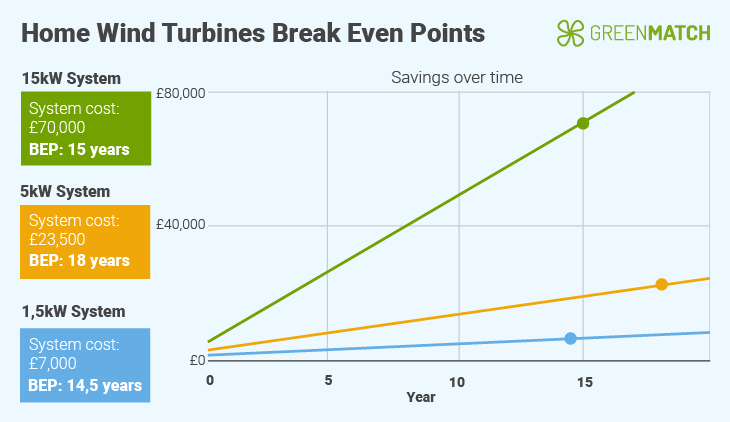
Once you’ve reached the break-even point, you’ll be able to generate free electricity for the rest of your turbine’s lifespan, which usually lasts around 20 years. This implies you can enjoy several years of cost-free, renewable electricity.
Furthermore, the Smart Export Guarantee (SEG) program allows homeowners to sell excess energy back to the grid, generating additional revenue. Even though the installation costs might be high, home wind turbines are becoming an increasingly appealing choice for UK homes. This is due to the potential for income and long-term savings, essentially as energy bills continue to grow.
Installation process of home wind turbines
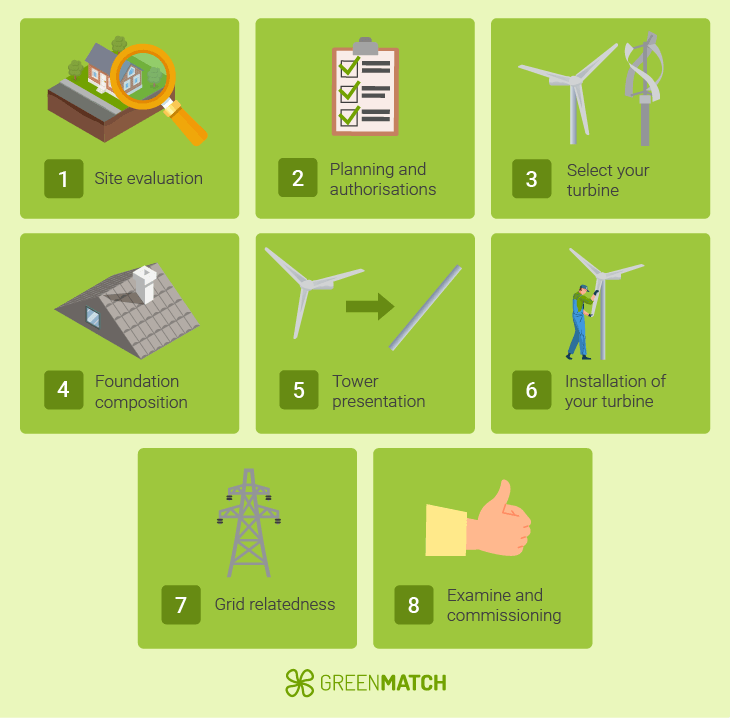
- Site evaluation: Professionals such as wind resource assessment experts, renewable energy engineers, environmental impact assessors, and meteorologists specialising in wind patterns who have gained certifications such as certified energy manager (CEM), and certified measurement and verification professional (CMVP), can rate your home's wind assets and eco-friendly aspects for a turbine.
- Planning and authorisations: It’s fundamental to obtain the necessary planning authorisations, such as planning permission and microgeneration certification scheme (MCS).
- Select your turbine: Decide on an appropriate turbine for your home based on the site evaluation and energy requirements.
- Foundation composition: Course-specific foundations for standalone turbines or strengthening the roof for roof-mounted systems.
- Tower presentation: Set up the tower or support construction for the turbine.
- Installation of your turbine: Arrange the turbine on the tower and align the electrical factors.
- Grid relatedness: A verified electrician will connect the turbine to your home’s electrical structure and the grid if suitable.
- Examine and commissioning: Consciously examine the system to make sure it functions properly and that it meets the safety needs.
Alongside this process, following the demands of local regulations and safety norms is critical. While the first investments can be crucial, a well-executed appliance can allow long-term energy savings and make you part of a more sustainable home energy solution.
Local regulations and safety norms required to install home wind turbines
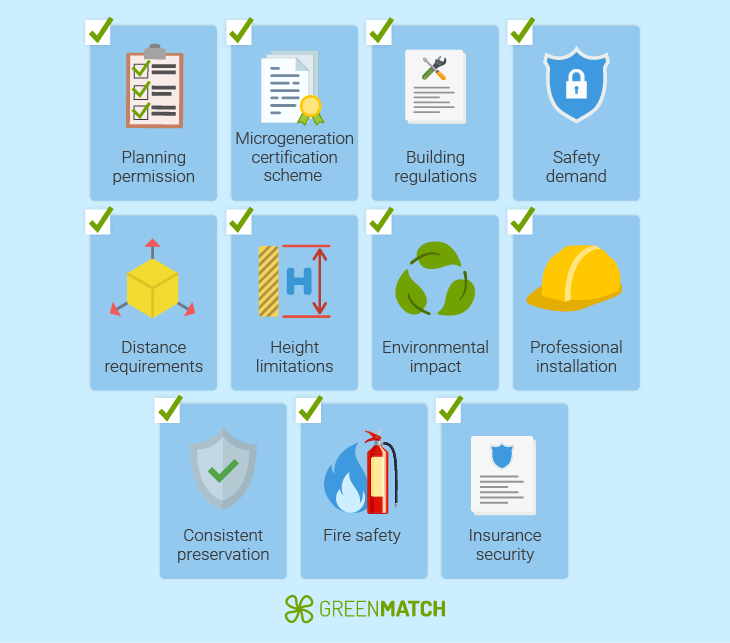
- Planning permission: In the majority of situations, planning permission is a demand for the installation of wind turbines. Nonetheless, some small-scale turbines might fall into ‘permitted development’ rights in England and Scotland if the right criteria is met.
- Microgeneration certification scheme (MCS): Wind turbines must complete the MCS standards.
- Building regulations: Installations must comply with local building codes to emphasise structural cohesion.
- Safety demands: It’s fundamental for turbines to meet the required safety standards regulated by the environmental permitting general provisions act (WABO).
- Distance requirements: There are particular demands from home boundaries and other buildings. For instance, a small standalone has to be more than 1.1 times their height away from the home’s edge.
- Height limitations: The turbine's height is adjusted, usually not exceeding 11.1m for standalone turbines or 3m above the roof for building-mounted ones.
- Environmental impact: The installation should not disturb regional fauna or be in a location with protected areas like World heritage sites.
- Professional installation: To ensure the process is safe and produces ideal performance, qualified professionals such as renewable energy engineers, should conduct the installation.
- Consistent preservation: Arranged inspections and maintenance are necessary to maintain safety and effectiveness.
- Fire safety: Efficient fire conquering measures should be in cite to decrease fire dangers.
Insurance security: Homeowners should modify their insurance policies in order to manage both the installation and functioning of the wind turbine.
How to maintain home wind turbines
Procedure inspections
Conduct consistent inspections to control the condition of moving parts which ensures early observation of tear and wear. By doing this you can help prevent inefficiency or possible mechanical issues. Additionally, while homeowners can execute simple visual checks, professionals are necessary for extensive inspections that should be performed twice a year.
Component check-ins
Gears, brakes, and other mechanical elements require anticipated servicing to avoid malfunctions. Systematic lubrication and arrangements are necessary to maintain a smooth procedure. These duties should be completed by professionals, since it involves heights and complex mechanical and electronic systems.
Comparison of home wind turbines to other renewable energy solutions
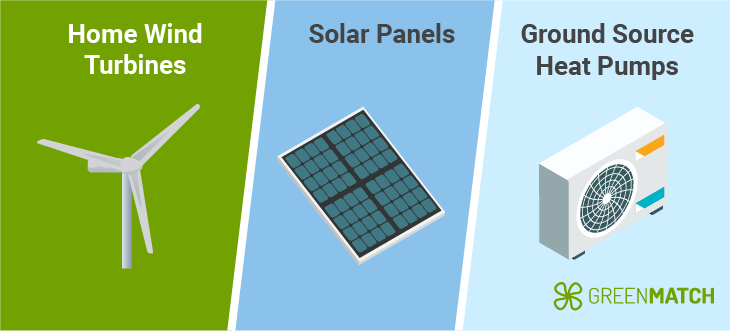
It’s essential to weigh the costs and advantages of different technologies when considering renewable energy options for your house. Let’s examine the differences between home wind turbines and other popular and affordable options.
| Feature | Home Wind Turbines | Solar Panels | Ground source heat pumps |
|---|---|---|---|
| Cost | With a 1.5 kW system it costs £7,000 going up to £70,000 for a 15 kW system for a standalone type | With a system size 2 kW it costs £2,500, being this the cheapest option ranging up to £10,500 for a 6 kW | £16,200 and £49,000 |
| Annual energy production | A 6 kW can generate roughly 9,000 kWh annually | A 4 kW can generate roughly 4,200 kWh annually | Provides heating and hot water. Reduces long-term bills for heating in nearly all UK properties. |
| Space demands | More space required making them more convenient for coastal or rural locations | Flexible, easy to install on the majority of rooftops | Less open space, although they require land for the ground arrangement |
| Location suitability | Require a concrete windy environment, typically of at least 5 m/s. Convenient for coastal or rural locations | Most locations, don’t have regional limitations | Most UK properties |
| Maintenance | More care and attention required | Less maintenance | Regular maintenance. Such as, Annual Professional Inspections and filter maintenance |
| Lifespan | Up to 20 years | 25 to 40 year lifespan | 20 to 25 years, sometimes more, for indoor factors. |
| Efficiency | Transforms about 20% to 40% of wind’s dynamic energy into electricity | Average efficiency is about 20% for domestic systems, while more costly can be between 40% and 50% | Around 320% for Microgeneration Certification Scheme (MCS) installations |
| Government incentives | Varies. For instance, the Smart Export Guarantee (SEG) or VAT exemption (2022-2027) | Varies. For instance, the Smart Export Guarantee (SEG) or 0% VAT until March 31st 2027 | Eligible for the Boiler Upgrade Scheme, which covers the installation and cost, offering homeowners up to £7,500 |
Is your home suitable for home wind turbines?
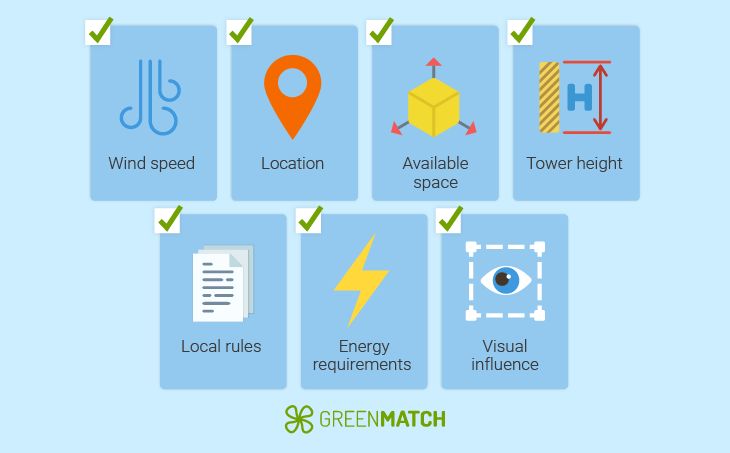
In order to determine if your home is suitable for home wind turbines, consider these key points.
- Wind speed: Your home should be located in an area with an average wind speed of at least 5 m/s for efficient energy generation. Regions with congruent winds above 6 m/s are the best ones for maximising output.
- Location: They are best designed for elevated, open places in coastal and rural areas. Urban and suburban communities are usually unsuitable because of wind turbulence caused by buildings, trees, and other barriers.
- Available space: You need enough open space away from obstacles such as buildings. Experts tend to recommend 0.4 hectares of empty land.
- Tower height: The majority of home wind turbines demand towers between 24 to 37 meters tall in order to gain access to stronger, more coherent winds.
- Local rules: It’s important to check the laws of your home region, building codes, and homeowners association rules that regard wind turbines. Some regions limit height and prohibit them completely.
- Energy requirements: Acquire your electricity consumption in order to discover the turbine size that is appropriate for your home. The majority of homes need 5 to 15 kW systems to balance out a notable fragment of their usage.
- Visual influence: Have in mind the aesthetic impact on your home and neighboring districts. If your property meets the required criteria, it might be appropriate for a home wind turbine. Nevertheless, a professional evaluation is suggested to discover the feasibility and possible power output for your concrete location.
Are home wind turbines worth it?
Home wind turbines can be worth it. For suitable homes with wind speeds no less than 5 m/s, they provide notable advantages, such as being more sustainable and offering potential savings.
More than 80% of UK residents approve the eco-friendly technology, and nowadays, wind energy generates over 24,600 mW of electricity annually. This is 20% of all the electricity in the UK, and 54% are renewable.
Standalone wind turbines are capable of saving homeowners up to £741 per year on power costs, possibly offsetting 50% to 90% of energy bills. A well-located 5 kW turbine in a region where the average wind speed is about 12 mph could lead to roughly 8,000 kWh annually, deflecting up to 75% of a usual home’s energy necessities.
Furthermore, the preliminary investment is fundamental. The price of standalone turbines is between £21,000 and £30,000 for a 6kW system, meanwhile, small roof-mounted systems are priced around £3,000 for a 1 kW system. The break-even position for nearly all systems varies from 14 to 20 years.
To conclude, home wind turbines can be worth it for homes located in windy coastal or rural areas with enough space for standalone systems.
FAQ
Yes, home wind turbines can be worth the money. They’re essentially worth it for homeowners in coastal or rural areas as those have strong winds frequently. However, they do require notable upfront costs and visible outdoor space.
To power a property in the UK, it’ll require a home wind turbine in the 5 to 15 kW range. The concrete measurement varies based on your home’s energy consumption and the wind speed in your location. It’s important to calculate your energy requirements from utility costs. Upgrading your home’s energy efficiency will decrease the turbine size you need.
A 5 kW wind turbine in the UK costs around £23,500 for a standalone or free-standing system. It’s important to bear in mind that the prices can differ as they rely on the chosen manufacturer and particular installation demands.
A wind turbine tends to last between 20 to 25 years with the proper maintenance. There are a few factors that affect the turbine’s lifespan.

Carmen is a writer at GreenMatch who has a strong interest in renewable energy and finds purpose in educating others on sustainable practices that will help create a more environmentally friendly future. Her attention to detail and dedication to accuracy ensure that every piece is reliable and helpful.
We strive to connect our customers with the right product and supplier. Would you like to be part of GreenMatch?

- What is a home wind turbine
- Types of home wind turbines
- Pros and cons of home wind turbines
- Wind turbines in the UK
- Costs of home wind turbines
- Installation process of home wind turbines
- Comparison of home wind turbines to other renewable energy solutions
- Is your home suitable for home wind turbines?
- Are home wind turbines worth it?
- FAQ
